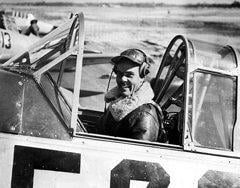Before World War II, few African-Americans have flown an airplane as the pilot-in-command. In 1941, Eleanor Roosevelt (then America's First Lady) makes history when she flies in a small plane piloted by an African-American.
A flying school for blacks has opened in Tuskegee Alabama, and Eleanor’s flight gives her husband, President Roosevelt, a lot to consider. For example: Shouldn't African-Americans have the same rights as whites to fight for their country during WWII? Shouldn't they have the right to be pilots?
Long before FDR becomes President, Bessie Coleman (an African-American from Chicago) dreams of flying. No flight school in the U.S. allows her (or any female or any person of color) to take flying lessons, so she moves to France to pursue her goal.
By 1921, Bessie has her pilot’s license and travels throughout America demonstrating her skills as a stunt pilot. She hopes to raise enough money to open a flying school for African-Americans but dies during a flight in 1926. Even after her death, she is a role model for black pilots.
Before—and during—WWII, all branches of the U.S. military services are segregated. The federal government allows African-Americans to join the Army and Navy, but they work in menial jobs (since a government report concludes they are less capable than white soldiers).
Eventually President Roosevelt signs Executive Order 8802. This allows people of color to serve as military pilots. Graduates of the Tuskegee Institute, in Alabama, form the 99th Army Air Corps Pursuit Squadron and soon prove their expertise in air battles against the Germans in the skies over Italy.
The "Red Tails," as they become known because the tails of their planes are red, are fierce protectors of American bombing missions. Serving as escorts on those bomb runs, Red-Tail crews shoot-down many German planes.
In this story about the men and their missions:
- Examine the history of military prejudice against African-Americans;
- Learn about eleven of the Tuskegee pilots and see photos of them with their planes;
- Discover the differences between American bombers and German bombers during WWII;
- Find-out about another secret taking place at Tuskegee involving medical experiments; and
- Listen to African-American pilots who tell us they were fighting for more than just their country during WWII.
Exploring this period of American history comes alive at AwesomeStories. Depending on a teacher’s preference, students can:
- “See” the story unfolding before their eyes in class (then view it, with their parents, at home);
- “Hear” the story (via a provided dramatized narration);
- "Think about” the story (with essential questions, such as “Are personal experiences more reliable than personal expectations?”); and
- “Study” the story (with lots of pictures and videos, including a clip of African-Americans talking about their aim of a “Double Victory” during WWII).
Using an integrated approach—combining STEM, visual arts, historical materials and language arts—students investigate the story in personalized-learning fashion with words and concepts suitable for a range of achievement levels. Students can then create their own stories, using the AwesomeStories’ archive of primary sources, to produce their own related stories to share with their class, their family and (if accepted for publication) … the whole online world!
Media Credits
Captain Benjamin Oliver Davis, leader of the 99th Pursuit Squadron, in the cockpit of a trainer at the airfield in Tuskegee, Alabama on the 23rd of January, 1942. Image online via U.S Air Force.





